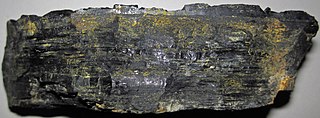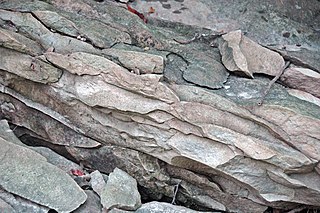
Balanerpeton is an extinct genus of temnospondyl amphibian from the Visean stage of the Early Carboniferous period. It reached approximately 50 cm (20 in) in length. Balanerpeton woodi was discovered by Stanley Wood and is the earliest and most common tetrapod in the East Kirkton Limestone of the East Kirkton Quarry assemblage of terrestrial amphibians in Scotland. Characteristics of Balanerpeton woodi include the presence of large external nares, large interpterygoid vacuities, and an ear with a tympanic membrane and rod-like stapes. Numerous studies and research regarding ontogeny in non extant taxa have been oriented around this taxon. The morphology of the stapes suggests that the animal was capable of hearing high-frequency sound. B. woodi does not possess lateral line sulci or an ossified branchial system. The principal method of respiration was probably buccal rather than costal, indicated by the small straight ribs.
Kirktonecta is an extinct genus of microsaur known from the Carboniferous of West Lothian, Scotland.

The Hinton Formation is a geologic formation in West Virginia. It preserves fossils dating back to the Carboniferous period. It is mainly made up of limestone, sandstone, and shale.
The Williamsport Sandstone is a sandstone geologic formation in West Virginia, Virginia, Pennsylvania, and Maryland. the formation includes the Cedar Creek Limestone member. Near Cumberland, Maryland it includes the Cedar Creek Limestone member. It preserves fossils dating back to the Silurian period.

The Washington Formation is a coal, sandstone, and limestone geologic formation in West Virginia. It preserves fossils dating back to the Permian period.
The Dundee Limestone is a geologic formation in Michigan, Ohio and Ontario. It preserves fossils dating back to the Devonian period.

The Maxville Limestone is a geologic formation in Ohio. It preserves fossils dating back to the Carboniferous period.

The Harrodsburg Limestone is a geologic formation, a member of the Sanders Group of Indiana Limestone, of Mississippian age. It was named for Harrodsburg in southern Monroe County, Indiana by T. C. Hopkins and C. E. Siebenthal. It is made up primarily of calcarenite and calcirudite. It also may include some beds of dolomite and shale.

The Laurel Formation, also known as the Laurel Limestone or the Laurel Dolomite, is a geologic formation in Indiana and Kentucky. It preserves fossils dating back to the Silurian period.
The Chouteau Limestone is a geologic formation in Illinois, Iowa, Kansas, and Missouri. It preserves fossils dating back to the Carboniferous period.
The Grand Tower Limestone is a geologic formation in Illinois. It preserves fossils dating back to the Devonian period.
The Cape Limestone is a geologic formation in Missouri. It preserves fossils dating back to the Ordovician period.
The Orchard Limestone is a geologic formation in Scotland. It preserves fossils dating back to the Carboniferous period.

The Tyne Limestone is a geologic formation in Scotland. It preserves fossils dating back to the Carboniferous period.
The Staffin Bay Formation is a geologic formation in Scotland. It preserves fossils dating back to the Callovian of the Middle Jurassic. It consists of two members, the lower Upper Ostrea Member, which consists of dark grey, fissile mudstone with a shelly limestone bed, and laminated and rippled sandstones. While the upper Belemnite Sands Member consists of medium grained calcareous sandstones and siltstones

The Duntulm Formation is a geologic formation in Scotland. It preserves fossils dating back to the Bathonian stage of the Middle Jurassic. It forms part of the Great Estuarine Group. The lithology consists of interbedded fissile mudstone and monospecific oyster beds of Praeexogyra hebridica, with subordinate limestone and calcareous sandstone beds.
The Dounans Limestone is a geologic formation in Scotland. It preserves fossils dating back to the Ordovician period.
The Craighead Limestone is a geologic formation in Scotland. It preserves fossils dating back to the Ordovician period.
The Stinchar Limestone is a geologic formation in Scotland. It preserves fossils dating back to the Ordovician period.
The Prout Limestone is a geologic formation in Ohio. It preserves fossils dating back to the Devonian period.








